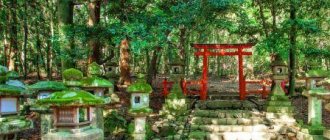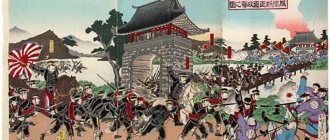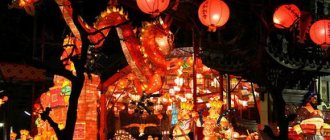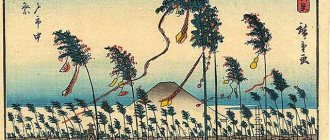Japan is a country rich in holidays. Here almost every day there is some kind of special event. Holidays in Japan are accompanied by games, competitions, dancing, singing, processions, and performances.
Numerous holidays, according to their content and origin, can be divided into groups: national, state, religious, traditional.
Ancient agricultural festivals occupy a significant place in the Japanese calendar. Holidays associated with rice cultivation are the most colorful. A number of holidays of contemplation of nature gave rise to the originality of oriental aesthetics.
Many holidays are dedicated to children. Hina Matsuri is the most famous of them.
But the Japanese, who love fun, relaxation and rich feasts, could not get by with only state-legalized national holidays. They also have Matsuri. Matsuri represent various festive processions, chants, traditional dances, fireworks, etc. So every city has its own traditional holidays - matsuri.
Public holidays in Japan
Officially, there are 15 public holidays in Japan. National holidays in Japan include: New Year (January 1), Coming of Age Day (January 15), Founding Day (February 11), Vernal Equinox Day (March 21), Greenery Day (April 29), Constitution Day (May 3), Rest Day (May 4), Children's Day (May 5), Day of Honor for the Elderly (September 15), Autumnal Equinox Day (September 21), Sportsman's Day (October 10), Culture Day (November 3), Labor Day (November 23), Emperor Akihito's birthday (December 23).
In Japan, in addition to state ones, a large number of religious and traditional holidays are celebrated, and all kinds of local festivals are also held. Let's consider the most significant and vibrant holidays.
Holidays by country
- Abkhazia
- Australia
- Austria
- Azerbaijan
- Asia
- Åland Islands
- Albania
- Algeria
- America
- Anguilla
- England
- Angola
- Andorra
- Antigua and Barbuda
- Argentina
- Armenia
- Aruba
- Afghanistan
- Bahamas
- Bali
- Bangladesh
- Barbados
- Belarus
- Belize
- Belgium
- Benin
- Bermuda
- Bulgaria
- Bolivia
- Bonaire
- Bosnia and Herzegovina
- Brazil
- Burkina Faso
- Burundi
- Butane
- Vanuatu
- Vatican
- Great Britain
- Hungary
- Venezuela
- Virgin Islands
- Vietnam
- Gabon
- Hawaiian Islands
- Haiti
- Guyana
- Ghana
- Guatemala
- Guinea
- Guinea-Bissau
- Germany
- Guernsey
- Honduras
- Greece
- Georgia
- Guam
- Denmark
- Dominica
- Dominican Republic
- Ancient Rome
- Egypt
- Zaire
- Zambia
- Zimbabwe
- Israel
- Ingushetia
- India
- Indonesia
- Jordan
- Iraq
- Iran
- Ireland
- Iceland
- Spain
- Italy
- Yemen
- Cape Verde
- Kazakhstan
- Cayman islands
- Cambodia
- Cameroon
- Canada
- Qatar
- Kenya
- Cyprus
- Kiribati
- China
- DPRK
- Cocos Islands
- Colombia
- Comoros
- Congo
- Korea
- Costa Rica
- Ivory Coast
- Cuba
- Kuwait
- Kyrgyzstan
- Curacao
- Laos
- Latvia
- Lesotho
- Liberia
- Lebanon
- Libya
- Lithuania
- Luxembourg
- Mauritius
- Madagascar
- Mayotte
- Macedonia
- Malawi
- Malaysia
- Malta
- Mariana Islands
- Morocco
- Marshall Islands
- Mexico
- Micronesia
- Moldova
- Monaco
- Mongolia
- Myanmar
- Namibia
- Nauru
- Nepal
- Nigeria
- Netherlands
- Nicaragua
- Niue
- NKR
- New Zealand
- Norway
- UAE
- Oman
- Isle Of Man
- Norfolk Island
- Pitcairn Island
- Saba Island
- Wallis and Futuna Islands
- Pakistan
- Palau
- Palestine
- Panama
- Papua New Guinea
- Paraguay
- Peru
- PMR
- Poland
- Portugal
- Puerto Rico
- Russia
- Rwanda
- Romania
- Salvador
- Samoa
- San Marino
- Sao Tome and Principe
- Sardinia
- Saudi Arabia
- Swaziland
- Northern Ireland
- Northern Mariana Islands
- Northern Cyprus
- Saint Kitts and Nevis
- Saint Lucia
- Serbia
- Singapore
- Syria
- Scandinavia
- Slovakia
- Slovenia
- Sudan
- Suriname
- USA
- Tajikistan
- Taiwan
- Thailand
- Tanzania
- Turks and Caicos
- Tibet
- Tokelau
- Tonga
- Trinidad and Tobago
- Tuvalu
- Tunisia
- Turkmenistan
- Türkiye
- Uganda
- Uzbekistan
- Ukraine
- Wallis and Futuna
- Uruguay
- Wales
- Fiji
- Philippines
- Finland
- Falkland Islands
- France
- Croatia
- CAR
- Chad
- Montenegro
- Czech
- Chile
- Switzerland
- Sweden
- Scotland
- Ecuador
- Eritrea
- Estonia
- Ethiopia
- South Africa
- Yugoslavia
- South Korea
- South Ossetia
- South Sudan
- Jamaica
Hanami - cherry blossom festival
The main spring event in Japan is considered to be the blossoming of sakura, which the Japanese call hanami. This ancient Japanese tradition of viewing flowers dates back to the 7th century.
The Sakura Festival in Japan is not an official holiday, but for the Japanese it is very important and significant. A huge number of people visit and spend their time in parks, squares and alleys during cherry blossom days. Since the cherry blossom period is relatively short (about two weeks), it is admired both during the day and in the evening. And the evening inspection is especially popular.
The time of the first blossoms of the cherry blossoms growing in Yasukuni in the ancient Buddhist temple is considered to be the official starting point. Meteorological services immediately begin to notify how the very first pink flowers appear from the buds. The approximate time for the city of Tokyo and its environs is the end of March.
Ume (Japanese plum) is the very first to start this “procession” of flowers. Sakura begins to bloom after Uma.
Constitution day
Since 1948, the third of May has been an official holiday, celebrating Constitution Day.
After defeat in World War II, the Japanese authorities were forced to change the country and accept the conditions of the victorious countries. Thus, in 1947, the sovereignty of the Japanese people was recognized, the country became parliamentary, and the great Emperor became a “symbol.”
Japanese holidays and traditions often date back to ancient times, but Constitution Day is relatively new and allowed Japan to develop after defeat and become one of the most powerful countries in the world.
Spring Festival in Japan
Setsubun is the four special days in the Japanese calendar that separate spring, summer, autumn and winter. These days, the Japanese perform purification rituals. Spring Eve, the time when nature awakens, is the most important of the four holidays.
The Spring Festival is famous for its funny-shaped rituals. The main purpose of such rituals is to ensure prosperity for the next year and expel evil spirits. During the holiday, on the door of every house you can see a hanging sprig of osmanthus, famous for its pungent smell and thorns.
Sweet white beans are the main attributes of the holiday. Many purification rites are associated with them in Japan. First, the beans are heavily roasted over a fire, and then they are scattered throughout various rooms, especially in dark corners.
Fireworks Festival on the Sumida River (Tokyo)
Rumor has it that the first festival took place in 1733. The Sumida River Fireworks Festival is one of the most popular (and crowded) summer festivals in Tokyo. With a history of nearly four centuries, it survived the Meiji Restoration and continued to be held until the world wars. The festival was reinstated in 1977 and celebrated its 40th anniversary in its current form in 2017. Visitors will be treated to a spectacular display of 22,000 fireworks, but be prepared - nearly a million people attended the event last year, so expect large crowds!
When: July 29, 2021, 19:05 – 20:30;
Where: Sumida River, Sumida-ku, Tokyo;
How to get there: the nearest station to the 1st venue: Asakusa or Honjo-Azumabashi, the closest station to the 2nd venue: Kuramae or Ryugoku.
Fertility Festival in Japan
The cult of the genital organs as a symbol of offspring and fertility has existed since ancient times in many countries. Japanese Shintoism was no exception here. At the same time, the theme of the phallus in the modern era is perceived in Japan, unlike Europe, as a natural thing, devoid of any vulgarity.
Thus, throughout the country there are many temples where female and male organs are worshiped. Moreover, this procession is not hidden; on the contrary, it is carried out with the organization of mass festivals, which attract thousands of people. Kanayami is one such temple.
A fertility festival called Honen Matsuri is held annually in mid-March and is celebrated throughout the country. The Japanese (usually childless women and men) come out in procession holding wooden penises of various sizes in their hands, asking for good harvests, sexual strength and many children.
Shinto shrine maidens open mass ceremonies with the dance of Young Miko.
On this day, the Japanese drink a lot of sake, as this drink is considered a symbol of the harvest. Participants buy various souvenirs and food in the shape of phalluses.
Children's Day
Children's Day, or the so-called Boys' Day in Japan, is celebrated on May 5th. All over the country, flags with koi nobori - carp - are flying.
According to ancient legend, a koi carp living in a deep, swampy pond was able to overcome all obstacles and cross the Dragon Whirlpool Falls. After that, he changed: a simple carp became a dragon and ascended to the distant skies.
It is for its strength and resilience that the image of a carp is used in celebration. So the boy must follow the example of the fish and turn into a real man.
Lantern Festival in Japan
The Kanto Matsuri Festival is one of the most vibrant and spectacular festivals in Japan. It is celebrated annually from August 4 to 7 in the northeast of the country in the city of Tohoku. This tradition originated during the Edo era (mid-18th century). Then the peasants suffered from disease and hunger. And Kanto Matsuri was that holiday when people asked for a good harvest, long life and health. Special designs were made for the holiday: many lanterns were hung on bamboo branches. These designs had their own name - Kanto. A sprouted rice sprout symbolized each Kanto.
In the 19th century, the lantern festival gained great popularity. So, processions with lanterns began to take place on the streets of the city. The culmination of the holiday was that each participant carrying Kanto tried to lift it up as high as possible. And today, a very important role is played not by how participants can raise their Kanto quickly and high, but by how they will do it.
Usually the lantern festival begins when evening falls in the city. Thousands of people come out of their homes to admire the solemn procession. Men carrying huge Kanto, to the sounds of music and screams of spectators, demonstrate extraordinary skills of dexterity and balance: they climb onto each other’s shoulders, while not letting go of the Kanto from their hands, put it on their foreheads, throw poles from their hands to their hips, and much more. The festival participants really work wonders.
The placement of the flashlights is very important for maintaining balance. Therefore, symmetry must always be maintained in the design. The lanterns depict the professions of the Kanto owner, as well as symbols of the area.
Usually about three thousand people take part in the festive procession, carrying 200 large Shiites in their hands.
Obon
From the thirteenth to the fifteenth of August, a holiday is held throughout Japan during which the memory of the dead is honored. The three-day Lantern Festival obliges Japanese people to visit the graves of deceased family members.
When darkness falls, people release paper lanterns to symbolize the souls of the dead. According to Buddhism, lanterns will help souls find their way home.
Although Obon is not an official holiday, almost all offices and companies close for this period. Every Japanese tries to visit their home and remember the memory of departed family members.
Chrysanthemum Festival in Japan
One of the most ancient and important holidays in Japan is the Chrysanthemum Festival, which is celebrated in the 9th lunar month. It was the ninth lunar month in the traditional Japanese calendar that was called the month of chrysanthemums.
The chrysanthemum flower occupies a special place in the life of the Japanese. The chrysanthemum is a symbol of the Japanese imperial house. The image of this flower can be seen on the covers of Japanese foreign passports, on the attributes of politicians, on the premises of parliament, in diplomatic institutions, on coins, and on the imperial seal. This flower is also considered a symbol of longevity.
During the Chrysanthemum Festival, Japanese florists create huge dolls from living chrysanthemums. These are mainly characters from literary works, legendary heroes and real historical figures.
Also on this day, various dishes and drinks are prepared from chrysanthemums: wine, tinctures, salads, flower-shaped sweets and much more.
Mothers Day
Traditional Japanese holidays include Mother's Day. On the tenth of May, every Japanese family congratulates their mothers. Although in recent years this holiday has become just a way to sell more gifts for dear mothers.
A week before the holiday, so-called gifts for mothers are put up for sale in Japan: aprons, bags, dresses, wallets, cosmetics, perfumes, etc. Advertisements for brands offering discounts and gifts are shown on television.
But regardless of this, all Japanese revere their mothers. They believe that mothers are the center of every family and the entire society as a whole.
Koenji Awa Odori (Tokyo)
Originating in Tokyo approximately 56 years ago, the festival is now considered one of Tokyo's largest and most famous summer events of its kind. With 10,000 dancers walking through the streets of Koenji, the small area manages to attract about a million visitors every year. It is crowded, but the experience of such unbridled fun is priceless!
When: August 26-27, 2021, 17:00-20:00;
Where: Sugunami-ku, Tokyo, Koenjiminami 2nd, 3rd and 4th chome, Koenjikita 2nd and 3rd chome
How to get there: Koenji Station.
Fukagawa Matsuri (Tokyo)
The Fukagawa Festival, officially known as the Fukagawa Hachiman Matsuri, is one of the three great festivals of Edo along with the Kanda Matsuri and the Sanno Matsuri. The Fukagawa Festival is held at the ancient Tomioka Hachimangu Shrine in the Koto district. Since 1642, the festival has featured a procession of mikoshi (portable shrines) where 120 mikoshi are paraded through local streets while spectators splash water on the participants.
When: August 11-15, 2021, 9:00-21:00;
Where: Tomioka Hachimangu, 1-20-3 Tomioka, Koto-ku, Tokyo;
How to get there: Monzen-nakacho Station, Exit 1.
New Year holidays end on Sunday, Monday January 4 is a working day
“Work completion day” on December 28, 2021 falls on Monday; office workers and government employees begin to rest on Tuesday, December 29. Since the three New Year's days fall on Friday, Saturday and Sunday, work begins on Monday, January 4, the New Year's holiday is slightly shorter than usual, about a week. However, in just a week we will have three more days off in a row.











